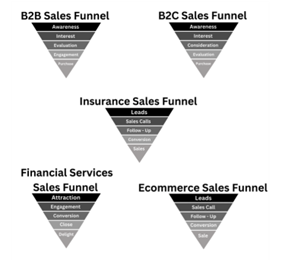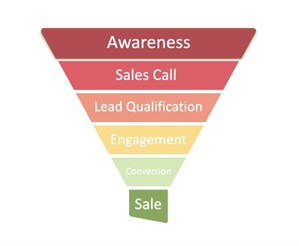
As the market becomes increasingly volatile, the invisible holes within your funnel grow, resulting in lost prospects and lost sales.
An Overview/Review
A sales funnel is a marketing and sales tool used to illustrate the process a customer follows when purchasing a product or service. The terminology “funnel” is used because the number of customers that start at the top reduces significantly through each layer, resulting in only a small portion converting into paying customers. The concept of a sales funnel has been used for over a century. While it has been innovated and improved over time, every company knows they lose potential sales throughout each step of the funnel. In times of market volatility, it is more important than ever to create efficiency in the sales process and optimize resource allocation. Plugging the holes within your sales funnel is crucial for maximizing your overall conversion rate and improving your bottom line.
Each vertical has its own layers in the funnel depending on the product or service being offered, the channel(s) being used, the lead generation techniques, the length of the average sale, and conversion techniques.
Image 1: Sales funnels for various verticals

The underlying concept in all sales funnels is very similar, so for the purpose of this article we will look at one generalized sales funnel.
Image 2: One sales funnel to rule them all – representative funnel for all verticals.

In this article, we will inspect each step in the funnel and highlight the pitfalls throughout the process. Additionally, solutions will be identified to help readers improve their sales efficiency and transactions.
Uncertainty is Not Your Friend
At the best of times, when the economy is in a good place, companies will ALWAYS lose potential customers throughout the funnel. Large, successful companies with well-thought-out sales funnels still lose customers at each stage. But, what happens when there is uncertainty in the market? Your holes expand. You lose more prospects at the top of the funnel, and more potential customers at each following stage. People are less likely to want to spend their money, so demand decreases. Additionally, the sales process typically lengthens. People think about their purchases longer and doubt where they want to put their money. Ultimately, market volatility results in more loss in the funnel.
Awareness
Awareness is the first point at which a customer becomes aware of a product or service being sold. During the awareness phase, having various marketing strategies and advertising techniques in place creates the most visibility on what is being sold. It is essential to have a good understanding of your target market, as it will guide your choice in how to properly market your product/service towards them. Persistence in this stage of marketing and advertising is crucial as it will only increase your product/service’s visibility.
Holes:
- Using the wrong keywords so people cannot find you.
- Using the wrong platforms to try and reach your target audience.
- Running under stealth mode may be unintentional. Nevertheless, you need to make content accessible and simple to find.
Lead Qualification
Lead qualification is the process of assessing the suitability of prospective customers. This involves assessing their interest level, readiness to make a purchase, and the fit of what is being sold based on their needs/wants. This step is important because it determines how much time and attention should be allocated towards a customer. Focusing on a lead with the most potential of converting, it helps optimize the sales process. Having an understanding of customers’ demographics, budget, and pain points looking to be fixed etc, are layers of criteria that determine their suitability.
Holes:
- Being in front of the wrong person/people.
- Not understanding a customer’s needs or processes.
Engagement
Engagement is the amount of involvement or interactions a potential customer has with your brand throughout the whole sales process. It looks at how much a lead actively communicates or engages with your marketing and communication channels. Engagement also indicates your lead’s level of interest and potential commitment to your product or service, providing insight into conversion potential. In addition to the nurturing process, measuring engagement will show you and your sales team how effective your marketing strategies are.
Holes:
- Too many emails / follow-ups will turn them off.
- Engagement emails offer no perceived value.
Conversion & Sale
Conversion is the transition from a prospect to a customer once a transaction has been made. This is the ultimate goal of the entire sales funnel, with the hopes of propelling as many prospects as possible towards this step. Having a high conversion rate indicates that your company has an effective sales funnel with a proper marketing plan in place. Conversion rates can always improve since no single company has a perfect rating. Every sales funnel has its holes.
Holes:
- Wrong people on the call.
- Disconnect with their pain point vs a “nice to have”.
- No clear path for POC or sales process.
At each of these stages, uncertainty in the market and economy makes people even more likely to rethink their needs, requirements, and purchase decisions. Problems like dramatic exchange rate changes, recessions, and the pandemic have been exacerbated in the last few years. For example, a survey published in Springer showed that business sales dropped by 17% on average due to the pandemic during the second quarter of 2020 in California.
Plugging the Holes
The traditional approach aims to bring as many people as possible to the top of the sales funnel, hoping that a large portion will convert into paying customers. However, this method can be both inefficient and costly. Let’s say initially 100 individuals enter the funnel, and only 10 make a purchase. Next, 1,000 people enter the funnel, yet only 10 converted. What went wrong? It becomes evident that a significant amount of money was wasted on spreading awareness instead of focusing on prospects with higher potential.
To address this issue, it is vital to implement a better filtering process and allocate marketing resources more strategically. By targeting suitable prospects, you can plug the leaks in your sales funnel, increase sales numbers, and improve your conversion rate. It is essential to prioritize the most interested prospects and guide them through the funnel in a timely manner while their enthusiasm is high.
Research shows that for the first hour a lead waits for a callback from a sales representative, their likelihood of making a purchase decreases by 20%. Each additional hour adds another 5% reduction, resulting in a 35% drop in the likelihood of a sale after 4 hours. Efficiency and working quickly in the sales process is critical, as customers who are excited and ready to buy at the top of the funnel prefer not to wait.
Ways to do it
Various different applications can be implemented into any vertical to improve the pre-sale efficiency and ultimately eliminate many holes within a sales funnel. Cloudonix is one example that provides software defined communication via voice API’s. This allows for a “click-to-call” application to be virtually anywhere (websites, emails, mobile apps etc.), connecting consumers to the company’s call center instantly. When a consumer does not need to wait for a callback, and there is no “hold” time on the phone, the likelihood of a sale going through is astronomically higher. This singular application addresses the “Leads Response Time Stats” article, streamlining this pitfall and blocking a massive hole. According to the “Click-to-Call” article, 30%-50% of customers’ sales will go to the first business that calls them back regarding their inquiry. A direct click-to-call application provides a service eliminating the need for a call back, resulting in a guaranteed response from a sales representative to your customer. Not only does this generally result in more revenue, and customers leave the transaction very satisfied. Although customer satisfaction does not directly correlate from a monetary standpoint, typically it would result in a high NPS, followed by a lower CAC. Using Cloudonix’s service allows for sustainable efficiency within your sales department as the whole pre-sales process is streamlined.
Another application that is applicable to any vertical is Openscreen’s interactive QR code, making consumer and enterprise engagement limitless. By providing simple information into the QR code, companies have the tools to know what you are interested in, and can provide faster personalized responses while the data is encrypted and private. Through digitizing physical and manual interactions, the sales process becomes streamlined, and companies’ overall conversion rate will improve. To add, the data that is obtained from the QR codes allows for companies to better understand who they should be targeting when finding prospective customers. This data helps plug holes near the top of the funnel in the “awareness” and “lead qualification” stages, which is significant for any company.
Both Cloudonix and Openscreen are two examples of API’s that can help create efficiency in the sales funnel while helping to plug large holes. To further enhance the sales process, targeting and filtering through the right prospects is essential. Spending time on people with little potential distracts from eager customers who should be addressed and brought through the sales funnel as fast as possible.
Some suggestions by level
Awareness
- Use the various tools to check on keywords that competitors are using and try to find ways to combine them for better search results.
- Put out relevant content on social media, write articles, posts, polls, etc. to spread awareness about your company and products.
- When marketing on social media, choose the platform(s) most suitable for your target audience. For example, if your core customers are 15–30-year-olds, Instagram or Tik Tok would be a strategic choice over Facebook.
Lead Qualification
- Have an ideal customer profile in mind. Include a rough outline of your target customer demographic and characteristics. Know your cohorts and how they find companies when they want to buy. HubSpot has a nice free tool for building personas.
- Listen to their description of the problem they are facing. This is not the phase for selling your solution, but for hearing their pain and recording it so that it can be utilized within the actual sales call.
- When setting the meeting or call be sure to ask, “Is there anyone else that needs to be invited?” This will help identify both the interest and the decision maker.
Engagement
- Focus on interactive and compelling content. Engagement relies on the amount of interactions a consumer/customer has with your marketing and advertising material. Make sure that there is some educational or other perceived value to the content and that it is not just another sales “flier.”
- Implement marketing automation and allow for personalized messaging. Make the messages and content engaging to keep prospects involved and interested. Pay attention to opt outs, do not spam, and other local regulations.
Conclusion
Although the concept of a sales funnel was conceived in the 19th century, it is still a fundamental tool in modern sales practices. Refining the funnel to fit your company’s specific needs is crucial to maximizing its effectiveness. Enhancing your pre-sales efficiency by investing in services such as Cloudonix or Openscreen, while allocating resources strategically, will improve your overall conversion rate. This will result in a positive return on investment and unlock potential to achieve greater success. Plug your holes, improve your bottom line.

